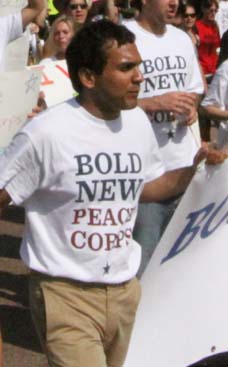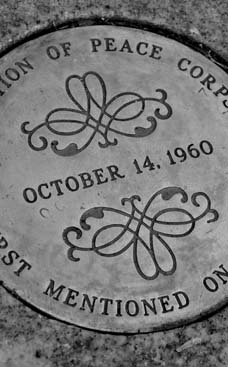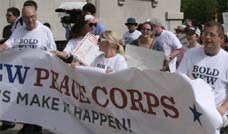
PCOL Comment: The recent deaths of Kate Puzey in Benin and Thomas Maresco in Lesotho highlight that the Peace Corps does not have a good procedure in place for death notifications to the families of volunteers who have died in service. The Puzey family was notified by a phone call that their daughter had died and the Peace Corps stonewalled details of the murder, so the family justifiably became frustrated, angry, and bitter at the way they were treated. Thomas Maresco Sr. says the FBI and Peace Corps officials were stingy about releasing any information concerning the shooting of his son. Organizations in law enforcement, mental health, military, and private industry have learned that how a death notification is delivered will have a profound affect on the surviving family for years to come because the proper handling of a death notification shows that the organization is concerned with the effects it may have on the survivors. The Peace Corps needs to put procedures in place to ease the suffering and pain of the grieving process of the families of volunteers who have died in service. Following is an article on how firefighters handle the situation that can provide guidance on the issues involved in death notification.
Excerpt from the article "All Due Respect" about how Firefighters handle a Death Notification: In the case of Muniz v. United Hospitals Medical Center Presbyterian Hospital, 379 A.2d 57 (1977), the hospital was found to be liable for an employee's "inhumane methods of telephone notification." Experts say delivering a death/injury notification over the phone should be a last resort. The best scenario is a face-to-face notification. If, as a last resort, a phone notification must be made, the chief of department should contact the local fire or police department in the survivor's area. Have a representative from the local department make the initial contact with the family. If you must deliver the message on the phone in the middle of the night, allow the survivor time to gain his or her bearings. A proper notification can keep the department from making matters even worse for the survivors. In addition, the proper handling of a death notification shows that the fire department is concerned with the effects it may have on the survivors. How a notification is delivered will have a profound affect on the family for years to come. Because of this, those making the notification should have specialized training/education in delivering death and injury notifications. The emotional and psychological characteristics of the bereaved family may be expressed in physical collapse, violent outbursts, dazed withdrawal, denial or the inability to take in the situation. Delivering a notification and not expecting this type of reaction can have an emotional impact on the notification team, resulting in additional problems in delivering the notification. Fire departments should have a written policy or guideline for a death/injury notification, the purpose of which is to provide the intended support to the family and the organization after a firefighter has been injured or killed in the line-of-duty. The notification guideline should include: Initiating the notification. Delivering the notification. Special considerations. Suggested comments. Things to avoid. Followup. A fire department lacking a formal policy can expose a survivor to the effects of a prolonged grieving process. R. Moroni Leash writes in Death Notification: A Practical Guide to the Process, "They [survivors] are revealed in the focus of the conversation, the expressive words chosen, and the notifier's response to the family's feelings. If the family members are familiar with the notifier and sense a genuine concern for their loved one and themselves, they will feel cared about, supported, and strengthened."
PCOL Editorial: The Peace Corps Needs a Procedure in Place for Death Notifications to the Families of Volunteers who have Died in Service to ease the Suffering and Pain of the Grieving Process of the Volunteer's Survivors and Families
All Due Respect
Dec 1, 2006 12:00 PM
By Paul J. Antonellis Jr.
One of the worst duties a fire chief has to perform is the delivery of a firefighter death notification. Unfortunately, fire chiefs across the country are called on to perform this task more than 100 times a year, in addition to injury notifications. Have you given death/injury notification any thought? Have you considered the long-term affects a notification has on the family? Have you done anything about it?
A proper notification can keep the department from making matters even worse for the survivors. In addition, the proper handling of a death notification shows that the fire department is concerned with the effects it may have on the survivors.
Needs assessment
As part of my thesis, I took a random phone sample of 50 fire departments in Massachusetts, approximately 14% of the fire departments in the state. I found that only 11 (22%) had a death notification policy in place. "Most departments do not have a lot of line-of-duty deaths, if any," said Chief William Shute of the Amesbury (Mass.) Fire Department. "I do not believe they are prepared to deliver that kind of news."
How a notification is delivered will have a profound affect on the family for years to come. Because of this, those making the notification should have specialized training/education in delivering death and injury notifications. The emotional and psychological characteristics of the bereaved family may be expressed in physical collapse, violent outbursts, dazed withdrawal, denial or the inability to take in the situation. Delivering a notification and not expecting this type of reaction can have an emotional impact on the notification team, resulting in additional problems in delivering the notification.
Fire departments should have a written policy or guideline for a death/injury notification, the purpose of which is to provide the intended support to the family and the organization after a firefighter has been injured or killed in the line-of-duty. The notification guideline should include:
Initiating the notification.
Delivering the notification.
Special considerations.
Suggested comments.
Things to avoid.
Followup.
A fire department lacking a formal policy can expose a survivor to the effects of a prolonged grieving process. R. Moroni Leash writes in Death Notification: A Practical Guide to the Process, "They [survivors] are revealed in the focus of the conversation, the expressive words chosen, and the notifier's response to the family's feelings. If the family members are familiar with the notifier and sense a genuine concern for their loved one and themselves, they will feel cared about, supported, and strengthened."
It's recommended that the chief of the department be responsible for delivering the notification to the firefighter's next of kin, but depending on the size of your department this may not be possible all the time. The notification process may be initiated by the senior staff, with the fire chief arriving at a later time. It's important that the fire chief be involved at some point during the notification. Not being involved could imply a lack of respect to the firefighter's family and the firefighter.
Experts also recommend that, in addition to the chief, the department chaplain be involved in the notification, if possible. I would suggest that a notification not be delivered by one person, but rather by a team of two. The second person in attendance may be a medical examiner, victim services counselor, family doctor, family clergy or a close friend of the survivor.
Some of the advantages of having two or more people deliver the notification are:
Gives emotional support for the notification team.
Allows a representative to remain at the house if the fire chief needs to leave.
Provides the opportunity for an uninterrupted notification.
Notification stages
The officer-in-charge of an incident in which a firefighter was killed should immediately review the firefighter's file and determine if anyone has been designated by the firefighter to inform his or her family. Those familiar with death notification strongly recommend having a firefighter in attendance who knows the family; this will provide emotional support to the survivors.
In the case of Muniz v. United Hospitals Medical Center Presbyterian Hospital, 379 A.2d 57 (1977), the hospital was found to be liable for an employee's "inhumane methods of telephone notification." Experts say delivering a death/injury notification over the phone should be a last resort. The best scenario is a face-to-face notification. If, as a last resort, a phone notification must be made, the chief of department should contact the local fire or police department in the survivor's area. Have a representative from the local department make the initial contact with the family. If you must deliver the message on the phone in the middle of the night, allow the survivor time to gain his or her bearings.
The notification team should be in clean official uniforms. The notification shouldn't be performed on the front door step, nor should it be performed in a public place. The notification team should be prepared to transport the family to the hospital if needed. One of the team members should be a compassionate listener.
The notification team should arrive at the survivor's location in separate vehicles. The notification should not be delayed until the whole team members can gather. Getting the family to the hospital before the firefighter dies, when possible, is preferable to waiting for the team to gather.
I also recommend having an ambulance stage about a block away from the location of a notification. A survivor may have a medical problem that the notification team is unaware of and may require medical assistance immediately after learning of the death/injury of a loved one.
Before delivering the notification the team should familiarize themselves with the circumstances of the death/injury. It's not uncommon for the family to ask for details about the incident leading up to the death/injury. If the notification team doesn't know the exact information and details, they shouldn't speculate. Tell the family, "I'm sorry, I don't have that information; however, I will find out for you." Make sure to follow through with your statement. Find out the information and inform the family!
According to Leash, the notification process generally can be broken down into a series of four steps, which she calls a "sequential notification technique." Research suggests that the notification team use the following steps in delivering a notification:
Ask the family members what they already know about the situation. This will serve as fact-gathering for the notification team. The team will want to find out how much information the family already knows and to what detail. This step will prevent the notification in repeating already known information and dragging the notification out for the family. Leach recommends, "Never begin with the statement, ‘I have bad news for you,' or ‘I'm sorry, but …'. Such an initiation throws the family member into panic, ultimately amounting to an abrupt notification."
Bridging from what they know, give family members a brief description of additional events that led up to the patient's arrival at the hospital. The second step will allow the notification team to bridge the information that the family already has with the information they need to know. The team will need to provide the family with a basic understanding of what led up to the injury or the death. For example, "Tom was returning from a car fire on his engine when a car ran a red light at the corner of Front and Pleasant. The car hit the side of the engine, and Tom was in the front officer's seat of the engine (pause). Tom was thrown into the side window and received a very serious head injury. He was flown by helicopter from the scene to the hospital." Be sure to use the firefighter's first name during the notification.
Give information regarding the resuscitative efforts made on behalf of the patient at the hospital. The third step allows the family to understand what medical efforts have been performed. Use plain language and do not use medical jargon. This step will lead directly into the fourth and final step. For example, "Tom arrived in the emergency room about 40 minutes ago. The doctors have run a number of tests and have determined that there is no brain activity (pause). Tom died about 10 minutes ago (pause), from the head injuries."
Conclude with the victim's response to the treatment, the statement of death, and a brief explanation of the cause of death. The fourth step allows the family to hear the word "dead" or "died." Those with experience in death notification say not to use phrases such as "passed on," "expired," or "it was too long." It can be very easy for the family to misunderstand these phrases; they are not clear in their meaning. If the firefighter has died, relay that information. Experts recommend the notification team never give the family a false sense of hope.
Experts in the field of death notification recommend when delivering a notification not to give the family the deceased's personal belongings. This can be done at a later time.
Once you have delivered the notification, your job is not done. The family shouldn't be left alone after receiving the notification. The team can offer to make phone calls for the family or to await additional family members, clergy or friends to be with the family. It's next to impossible to attach a time frame to the notification process.
Research suggests that the notification team provide the survivors with options and recommendations while allowing the survivors to make choices for themselves. This is often a challenge for members of a paramilitary organization. Let's face it, as fire chiefs, we give orders and directives. We want command and control. The notification process should be looked at as a very fluid process with sudden and unexpected ripples, and sometimes tidal waves.
If the notification team can't find the survivor, they should not tell neighbors or leave notes of the notification on the door. I would suggest that the best course of action is to just leave word that the survivor should contact the fire chief or the department as soon as possible. Once the survivor is located and notification is delivered, the notification team should advise the communications center to release a prepared press release with the facts regarding the fatality to the public. Under no circumstances should the name of the injured or deceased firefighter be released until the family has been notified.
After the notification
The notification process is often overlooked by the fire service with profound effects to the survivors. Think of the notification as being delivered in small intermittent doses rather than as one large dose of notification. Often the team's level of distress can lead to an abrupt notification. Janice Lord writes in Beyond Sympathy that "a person in distress may not be able to think about what needs to be done, and is even less likely to be able to be assertive enough to ask for assistance."
While the notification process has been detailed in length, this isn't intended to be an all-inclusive process. Fire chiefs, senior staff members, officers, and firefighters who are responsible for the delivery of a death/injury notification should take advantage of death notification training and reference materials. Cultural and spiritual issues play a significant role in delivering a death/injury notification. People throughout the world have different cultures. Thus their standards for behavior often differ. (See sidebar, opposite.)
A fire chief should be the person who starts the ball rolling in developing a death/injury notification policy. There's no need to reinvent the wheel; there is a wealth of reference material available. All it takes is directing the proper resources to carry out the task. You may be surprised to find out how many fire departments do not have a standing policy for a death/injury notification.
Additional education and training can be obtained from the National Emergency Training Center, Learning Resource Center (www.lrc.fema.gov), National Fallen Firefighters Foundation (www.firehero.org) or the International Critical Incident Stress Foundation (www.icisf.org). Collectively the fire service needs to dedicate the proper resources to this endeavor. For this to happen, fire chiefs need to make the first move, establishing a line-of-duty death/injury guideline. As Acting Chief C. Randall Sherman of the Yarmouth (Mass.) Fire Department says, "Don't ever think that it can't happen to you." Please remember, this is not about us, it's not about the firefighters, it's all about "our" families.
--------------------------------------------------------------------------------
A former chief of department, Paul J. Antonellis Jr. has more than 20 years of fire/EMS experience and 11 years of law enforcement experience. He is on the faculty for two colleges teaching in the undergraduate and graduate fire science program, has lectured to emergency service providers nationally and internationally, and has authored and published many articles and two books. He has associate's degrees in criminal justice and fire science technology, a bachelor's degree in fire service administration, and a master's degree in labor and policy studies.
Cultural & Spiritual Issues
Those with experience in grief counseling recommend the notification team have a clear understanding of the cultural differences that may exist when delivering a death notification. It is customary for Eastern cultures to emphasize the community's loss and the survivor's place in the community. The opposite is true of Western cultures, which may be very resistant to having a full fire department funeral. This being said, the fire department needs to respect the cultural wishes of the family.
Although spiritual beliefs mean various things to countless people, here they refer to a set of beliefs and practices that pertain to sacred things among a community of beliefs. Spiritual beliefs often provide myriad functions to people. Spiritual beliefs may produce a sense of communal solidarity and consensus. Many religions mark significant milestones in life - birth, maturity, marriage and, indeed, death.
Throughout the world different cultures are present. The standards for behavior during a death often differ with each culture. Research suggests that people tend to assume that certain behaviors have pretty much the same meaning around the world and anticipate that other people will act as they do. This misunderstanding should your attention to the need to understand the cultural differences in dealing with death. Your department guideline should respect the various cultures represented in your department.













